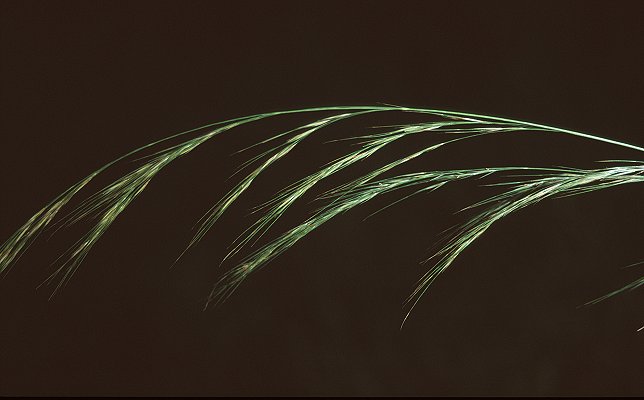 |
 |
|
 |
 |
|

Aristida macroclada Henrard |
Derivation
Aristida L., Sp. Pl. 1: 82 (1753); from the Latin arista
(an awn).
macroclada- from the Latin macro (large) and clados (branch),
derivation uncertain.
Published in
Meded. Rijks. Herb. Leiden 54A: 325 (1927).
Common synonyms
Aristida novaeguineae Ohwi
Habit
Perennial, tufted. Culms 60–100 cm tall, 5–9-noded. Mid-culm internodes
smooth, glabrous. Lateral branches sparsely branched. Leaf-sheaths glabrous
on surface. Ligule a fringe of hairs, 0.3–0.5 mm long. Collar glabrous.
Leaf-blades straight, flat or conduplicate or involute or convolute, 15–30
cm long, 1–2.3 mm wide. Leaf-blade surface glabrous or pilose.
Inflorescence
Inflorescence compound, a panicle. Panicle open, elliptic, 17–24 cm long,
3–7 cm wide. Primary panicle branches appressed, moderately spaced, 5–10
cm long. Panicle branches with prominent pulvini.
Spikelets
Spikelets solitary. Fertile spikelets 1-flowered, comprising 1 fertile floret,
without rhachilla extension, lanceolate, terete, 6–15 mm long, breaking
up at maturity. Spikelets disarticulating below each fertile floret. Floret
callus elongated, 0.5–0.8 mm long, pubescent, acute.
Glumes
Glumes persistent, similar, thinner than fertile lemma. Lower glume lanceolate,
4–11 mm long, 66–80% length of upper glume, membranous, 1-keeled,
1-nerved. Lower glume lateral nerves absent. Lower glume surface smooth to scabrous.
Lower glume apex emarginate, mucronate. Upper glume lanceolate, 6–15 mm
long, 110–160% of length of adjacent fertile lemma, membranous, 1-keeled,
1-nerved. Upper glume lateral nerves absent. Upper glume apex entire or erose,
emarginate or cuspidate, mucronate.
Florets
Fertile lemma lanceolate, subterete, 5.5–9.5 mm long, coriaceous, 3-nerved.
Lemma surface tuberculate or muricate, rough above. Lemma margins convolute,
covering most of palea. Lemma apex acute, 3-awned. Median (principal) awn 3-branched,
11–37 mm long overall, 10–29 mm long, with a straight or slightly
twisted column or with a twisted column, persistent. Column 1–8 mm long.
Lateral lemma awns present, 9–26 mm long, shorter than principal, 90%
of length of principal. Palea 20% of length of lemma, without keels. Anthers
3. Grain with adherent pericarp, terete, not grooved, 5–8 mm long. Embryo
25–50% of length of grain. Hilum linear.
Continental Distribution:
Tropical Asia, Australasia
Australian Distribution:
Northern Territory, Queensland.
Northern Territory: Darwin & Gulf. Queensland: Cook, North Kennedy.
Classification. (GPWG
2001):
Aristidoideae
Notes
Native. It exists as two subspecies, Aristida macroclada subsp. macroclada
with a very short column and Aristida macroclada subsp. queenslandica
with a fairly well developed column. Aristida macroclada differs from
Aristida psammophila and Aristida longicollis by the inflorescence
being loose to open and the branches being naked at the base.
| Column of many spirals | A. macroclada subsp. queenslandica (QLD) |
| Column of 1/2-1 spiral | A. macroclada subsp. macroclada
(NT QLD) A. novaeguineae |
Aristida macroclada Henrard subsp. macroclada
The "top end" of the Northern Territory, one record from Cape York Peninsula,
QLD, and a few records from New Guinea. Eucalyptus, and Melaleuca
communities on sandy and loamy soils. Flowering and fruiting January (one record),
March to July.
Aristida macroclada Henrard subsp. queenslandica B.K.Simon
Tropical coastal Queensland. One record from New Guinea. Eucalyptus,
Casuarina and Melaleuca communities on sandy and loamy soils.
Flowering and fruiting February to June, August.

Inflorescence (photo)
© Queensland Herbarium
Sharp 423 and Simon
by D.Sharp